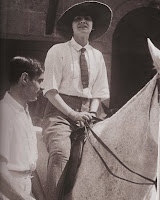 Of all the well known Chanel designs, the tweed jacket is one of the most iconic. The definition of chic to the modern woman, the little tweed jacket has its origin in British country menswear. One of the reasons why the Chanel look owes so much to traditional British style is not foreign to Coco’s English lovers.
Of all the well known Chanel designs, the tweed jacket is one of the most iconic. The definition of chic to the modern woman, the little tweed jacket has its origin in British country menswear. One of the reasons why the Chanel look owes so much to traditional British style is not foreign to Coco’s English lovers.The first time Chanel was influenced by menswear was while she was the mistress of Etienne Balsan, a wealthy French racehorse owner. Desperate to set herself apart from the other kept women on the horse tracks, she borrowed tailored coats and ties from Etienne and his friends, adding a straw hat she made for the occasion.
It wasn’t however until she met Arthur ‘Boy’ Capel, an English polo player and business man who financed her millinery shop in Paris, that she would truly express who she was, rather than who she didn’t want to be.
English polo player and business man who financed her millinery shop in Paris, that she would truly express who she was, rather than who she didn’t want to be. In 1913, just before WWI broke out, Boy Capel financed her shop in Deauville and later in Biarritz. There she sold hats but also jumpers, jackets, jersey cardigans, knitwear and sailor blouses.
This modern and easy look proved easily adaptable to women’s new lifestyle thanks to fluid and comfortable fabrics, and her garments became the wartime staple of the well-dressed ladies. Interestingly, most garments and materials were influenced by mens- and workwear. Chanel’s talent was in adapting this type of clothing to women’s role in society, which notably required an increasingly female workforce.Chanel always changed her look to reflect the lifestyle of her lovers, who mostly happened to be into sports. As a result, Chanel believed in being fit rather than relying on corsets and rejected anything that would infringe the movement of the body.
She started to design clothes for herself that were more fluid and would let her move freely. Her body image was very radical and modern for her time, and she would change her viewpoint throughout her career, always keeping up with the changing social norms.
Boy Capel, from who she borrowed blazers and jodhpurs when riding, had freed Chanel’s creativity. Of her designs she said,“I did not invent the sports suit because women were doing sports but because I was. I was not going out because I felt the need of making fashion; I made the fashion because I was going out, because I, the first, lived the life of the century”.
 During her involvement with the Duke of Westminster from 1926 to 1931, Coco took up the quintessentially English country style but more importantly used the Duke’s own style for her collections.
During her involvement with the Duke of Westminster from 1926 to 1931, Coco took up the quintessentially English country style but more importantly used the Duke’s own style for her collections.
A visit to one the Dukes’ tweed factories in Scotland gave her the idea of using this rough, resistant fabric for a jacket. The rest is history. There, living the typical British high life, complete with racing, fox hunting and salmon fishing, Chanel found many elements that charmed her and eventually brought them home to France to feature in her collections.
Her life with the Duke was essential to the making of the Chanel identity. It was during this time that Coco got the inspiration for her soft-belted coats, tweed jackets and blazers, sailor sweaters and cuff-linked shirts. True to her habit, Chanel borrowed from the Duke’s outfits on her outings. On his yacht, she wore the duke’s jackets, sweaters, pants and even shoes which caused quite a giggle but was simply what she liked to wear.
Back in London, Chanel continued to wear knitwear during the day but decided the simplicity of the garments required the contrast of sumptuous accessories.
She started sporting cascades of pearl necklaces, clusters of stones and the famous enam el bracelets, created for her by her new recruit at Chanel, Fulco di Verdura, a Sicilian duke who would soon make a career for himself in Paris, London and New York. The British society ladies at the time would never have thought of wearing such jewellery and even less so with knitwear.
el bracelets, created for her by her new recruit at Chanel, Fulco di Verdura, a Sicilian duke who would soon make a career for himself in Paris, London and New York. The British society ladies at the time would never have thought of wearing such jewellery and even less so with knitwear.
Chanel’s genius as a fashion designer not only lies in her ability to make clothes that reflect social changes and shifting gender roles but to draw inspiration from her personal life. She not only designed for the wealthy but for herself. The fact that her look prevails to this day is testament to her talent, her unconventional life and the men she loved.
